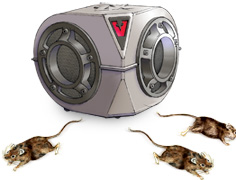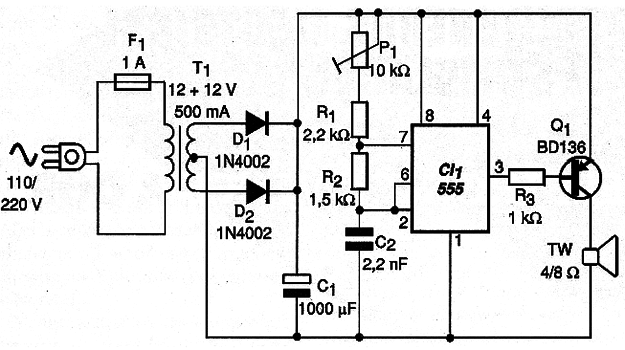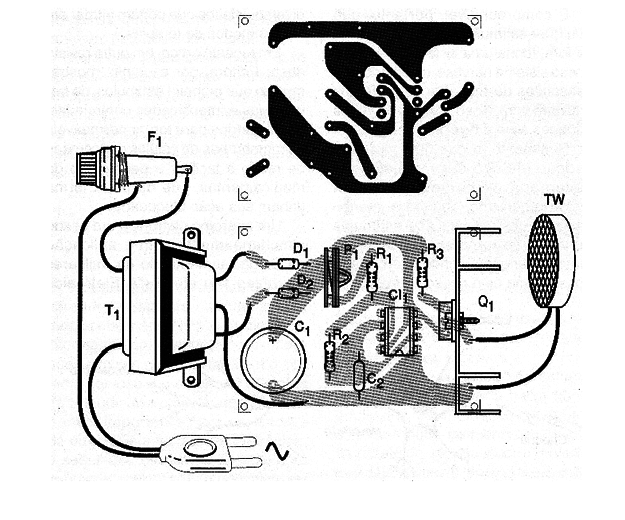Translated into English by Patricia Lima Carlos.
Animals such as rats and even small birds are bothered by the emission of ultrasonic signals of good power. In many countries, ultrasonic repellents are installed in silos to keep these animals away. In order to prove it, see the announcements in the agricultural section of the leading newspapers.
The simple circuit we describe is suitable for small environments and can be installed in a pantry, storage cabinet or even in a place where you can store some cereal or product which can be attacked by rodents. Placed next to trash cans it can also help keep dogs and cats away, avoiding the spillage of dirt or even the plastic bags being torn.
The circuit produces a good power signal in the range from 18 kHz to 25 kHz and can be kept on permanently as it is powered by the power grid. The power consumption will be between 2 and 5 watts depending on the transformer used and the efficiency in the emission of ultrasound is excellent thanks to the use of a piezoelectric tweeter.
The great advantage of this type of repellent is that it does not use chemicals and does not affect the environment. It is therefore an ecologically correct solution, which certainly has to be analyzed, not only in this type of application as in others. Sounds, ultrasound and non-ionizing radiation are important solutions for many types of equipment because they do not pollute.

Commercial Ultrasonic Repeller, Victorpest, sold through the Internet (In The United States).
CHARACTERISTICS:
Supply voltage: 110/220 V
Operating frequency: 18 kHz to 25 kHz
Output power: 2 to 5 W
HOW IT WORKS
An integrated circuit 555 is connected to the astable configuration producing a signal whose active cycle is small, as shown in Figure 1.

The active cycle is basically given by the ratio of values ??between R1 and R2 and the purpose of keeping this value low is to reduce the conduction period of time of the transistor. Being polarized only in the intervals where the pulse has a shorter duration, the transistor consumes less amount of energy and thus less heat.
However, the peak power is maintained. We can then use PNP medium-power transistors, such as BD136, or the equivalent, such as BD138 or even BD140, which must be have a small heat radiator. The transistor signals are applied directly to a high performance piezoelectric tweeter.
While most of these tweeters are designed to produce sounds in the range from 12 to 18 kHz, many of them have a good response in frequencies which go beyond 18 kHz, that is, above the range audible by humans, already in the ultrasound range. So we can use them as cheap ultrasonic transducers as long as the frequency does not go much further than 22 kHz.
The circuit power is supplied by a 12 V transformer with a current of 500 mA without the need for regulation. The diodes D1 and D2 rectify the low voltage of the secondary of the transformer while the capacitor C1 does the filtering.
ASSEMBLY
In Figure 2 we have the complete diagram of the Ultrasonic Repellent, including its power supply.

The arrangement of the components on a small printed circuit board is shown in Figure 3. Several components used admit equivalents such as BD136. Power PNP transistors such as TIP32 and TIP42 can be used.

The transformer has a 12+12 V secondary with a current between 500 mA and 1 A. The assembly fits easily into a small plastic band whose dimensions are basically determined by the size of the tweeter. In particular we recommend piezoelectric tweeters of the kind that has a “button” that are not more than 4 cm in diameter and provide excellent performance in the reproduction of high frequency sounds. The transistor must have a small heat radiator that is nothing more than a metal plate folded into a "U" and fastened with a bolt with q nut in the body of the component.
ADJUSTMENT AND USE
To adjust, connect the unit to the power grid and set the P1 until the high-pitched sound disappears (stays above the audible limit). After that, just install and keep the device plugged into places where rodents can attack.
It is important not to keep the device connected in places where there are pets such as dogs, cats and even birds as they may feel very annoyed by the signal produced by the repellent. Use only in places where these animals are not present.
Semiconductors:
CI-1 - 555 - integrated circuit, timer
Q1 - BD136 or equivalent - medium power PNP transistor
D1, D2 - 1N4002 or equivalent - silicon diodes
Resistors: (1/8W, 5%)
R1 - 2.2 k Ω (red, red, red)
R2 - 4.7 k Ω (yellow, violet, red)
R3 - 1k Ω (brown, black, red)
P1 - 10 k - trimpot
Capacitors:
C1 - 1000 µF / 25 V - electrolytic
C2 - 2.2 nF or 2.7 nF - ceramic
Miscellaneous:
T1 - A transformer with primary according to the local power grid and secondary of 12+12 V x 500 mA or more.
TW - 4 or 8 Ω - miniature piezoelectric tweeter
A printed circuit board, assembly box, power cable, heat radiator for transistor, wires, welder, etc.
Professor Ventura and the Ultrasonic Repellent
Not always an ultrasonic repellent can have quiet results, especially when you add oscillations which can also affect humans. In fact, studies show that humans do not hear and so are not affected. It may not be true.
Exploring this subject we wrote a funny story involving Prof. Ventura, Beto and Cleto in which the ultrasonic oscillator to repel bird becomes an oscillator capable of causing intestinal lack of control. See more in "The Dysenteric Oscillator" on Prof. Ventura’s section on this site.





